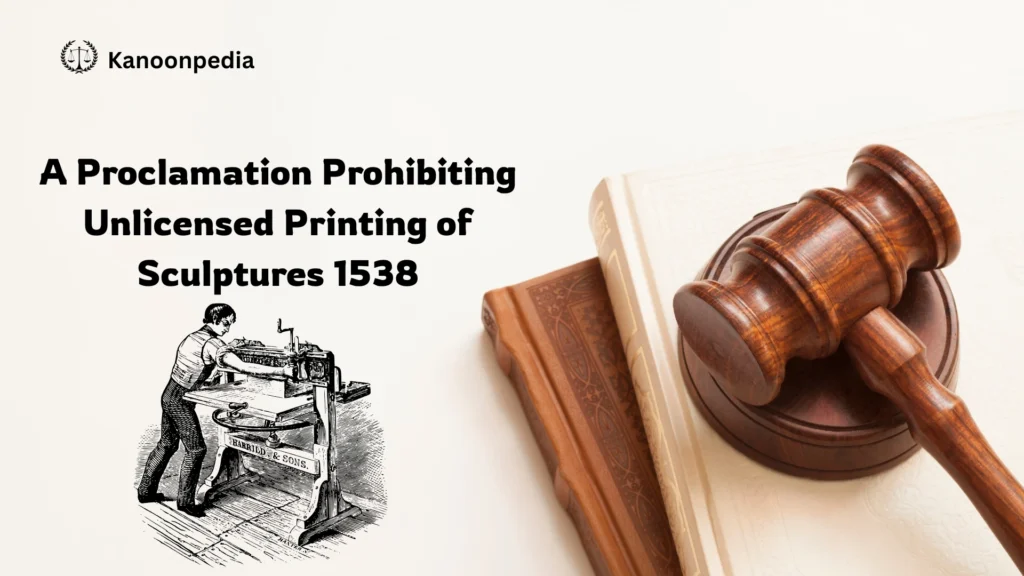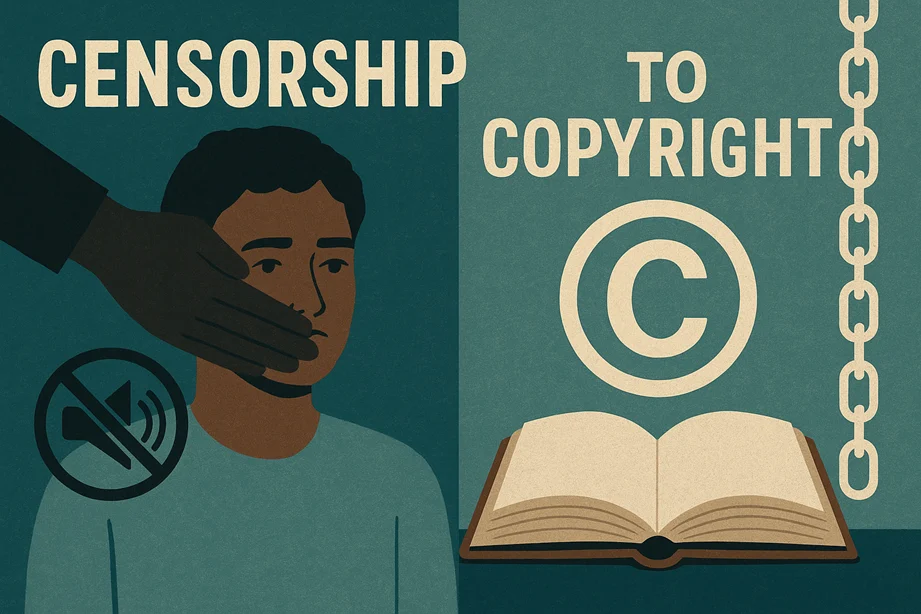Introduction
The early modern period in England was a transformative era, marked by sweeping changes in religion, politics, and technology. Among the most significant developments was the rise of the printing press, which revolutionized the dissemination of information and ideas. In response to this technological upheaval, the English monarchy sought to assert control over printed materials, culminating in a series of royal edicts. One of the most pivotal was A Proclamation Prohibiting Unlicensed Printing of Scriptures 1538. This proclamation not only shaped the trajectory of English print culture but also set enduring precedents for state regulation of information.

This comprehensive exploration delves into the origins, content, and impact of A Proclamation Prohibiting Unlicensed Printing of Scriptures 1538, examining its historical context, mechanisms of enforcement, and lasting significance for copyright, censorship, and freedom of expression.
Table of Contents
Historical Context: Why A Proclamation Prohibiting Unlicensed Printing of Scriptures 1538 Was Issued
The issuance of A Proclamation Prohibiting Unlicensed Printing of Scriptures 1538 cannot be understood in isolation. It was a direct response to the profound changes unleashed by the printing revolution and the English Reformation. The invention of the printing press in the late fifteenth century made it possible to produce books and pamphlets on an unprecedented scale. This democratization of information posed both opportunities and threats to the established order.
King Henry VIII, facing the twin challenges of religious dissent and political instability, recognized the need to control the spread of ideas. The proliferation of unlicensed printed materials—especially those with religious or political content—was seen as a danger to both the monarchy and the Church of England. As a result, the crown moved to regulate the press, culminating in A Proclamation Prohibiting Unlicensed Printing of Sculptures 1538.
The Provisions of A Proclamation Prohibiting Unlicensed Printing of Scriptures 1538
Establishing a System of Prior Restraint
At its core, A Proclamation Prohibiting Unlicensed Printing of Scriptures 1538 established a system of prior restraint. This meant that no book, pamphlet, or sculpture could be printed in England without first obtaining official approval—a license—from the Privy Council or ecclesiastical authorities. The proclamation explicitly targeted the unregulated printing of religious texts and other works deemed potentially seditious or heretical.
Mechanisms of Enforcement
The enforcement mechanisms detailed in A Proclamation Prohibiting Unlicensed Printing of Scriptures 1538 were rigorous:
- Licensing Requirement: Every printed work required examination and approval before publication.
- Scope: The proclamation applied to all books, whether in English or Latin, and extended to sculptures and other printed images.
- Penalties: Violators faced severe penalties, including confiscation of unlicensed materials and possible imprisonment.
By centralizing control over the press, the proclamation aimed to suppress dissent and maintain the ideological unity of the realm.
The Broader Impact of A Proclamation Prohibiting Unlicensed Printing of Scriptures 1538
Censorship and State Control
The most immediate effect of A Proclamation Prohibiting Unlicensed Printing of Scriptures 1538 was the establishment of state censorship as a norm. The proclamation was less concerned with protecting the rights of authors or printers and more focused on controlling the content of what was published. This distinction is crucial: the state’s primary interest lay in the propriety of information, not in the economic exploitation of creative works.

Influence on Later Legal Developments
The licensing system introduced byA Proclamation Prohibiting Unlicensed Printing of Scriptures 1538 persisted in various forms for over a century. It laid the groundwork for later regulatory frameworks, including the incorporation of the Stationers’ Company in 1557 and the eventual passage of the Statute of Anne in 1710—the first true copyright statute.
A Proclamation Prohibiting Unlicensed Printing of Scriptures 1538 and the Evolution of Copyright
From Censorship to Copyright
While A Proclamation Prohibiting Unlicensed Printing of Scriptures 1538 was not a copyright law in the modern sense, it represents a foundational moment in the history of information control. The proclamation’s emphasis on licensing and prior approval foreshadowed later developments in copyright, where the regulation of publication would increasingly focus on economic rights and the protection of intellectual property.
Decoupling Content Control from Economic Ownership
One of the distinctive features of A Proclamation Prohibiting Unlicensed Printing of Scriptures 1538 was its separation of content control from economic interests. Unlike later copyright statutes, which sought to protect the financial interests of authors and publishers, the 1538 proclamation was fundamentally about safeguarding the state and church from subversive ideas. This approach influenced governmental attitudes toward censorship for the next 150 years.
The Enduring Significance of A Proclamation Prohibiting Unlicensed Printing of Scriptures 1538
Shaping the English Public Sphere
The legacy of A Proclamation Prohibiting Unlicensed Printing of Scriptures 1538 extends far beyond its immediate impact. By institutionalizing prior restraint, the proclamation shaped the development of the English public sphere, influencing debates about free speech, censorship, and the role of the state in regulating information.
Precedent for Modern Regulation
Modern regulatory frameworks governing the press, broadcasting, and digital media can trace their origins to the principles established by A Proclamation Prohibiting Unlicensed Printing of Scriptures 1538. The notion that the state has a legitimate interest in overseeing the dissemination of information remains a contentious issue, with echoes of the 1538 proclamation evident in contemporary debates over media regulation and internet censorship.
A Proclamation Prohibiting Unlicensed Printing of Scriptures 1538: Lessons for Today
Balancing Freedom and Responsibility
The history of A Proclamation Prohibiting Unlicensed Printing of Scriptures 1538 offers important lessons for contemporary society. The tension between freedom of expression and the need for responsible regulation is as relevant today as it was in the sixteenth century. While the proclamation’s approach to censorship may seem draconian by modern standards, it underscores the enduring challenge of balancing individual liberties with the collective good.
The Role of Technology
Technological innovation continues to disrupt traditional modes of communication, just as the printing press did in the time of A Proclamation Prohibiting Unlicensed Printing of Scriptures 1538. The rapid spread of digital media has revived concerns about unregulated content, misinformation, and the potential for social harm. Policymakers and stakeholders can draw on the historical experience of the 1538 proclamation as they navigate the complexities of regulating information in the digital age.
The Proclamation’s Legacy in Legal and Cultural Memory
Influence on the Statute of Anne
The principles enshrined in A Proclamation Prohibiting Unlicensed Printing of Scriptures 1538 informed the drafting of the Statute of Anne in 1710, which is widely regarded as the first modern copyright law. While the Statute of Anne shifted the focus toward the protection of authors’ rights and the encouragement of learning, it retained the underlying assumption that the state had a role to play in overseeing the publication of information.
Cultural Resonance
The story of A Proclamation Prohibiting Unlicensed Printing of Scriptures 1538 continues to resonate in discussions about the limits of free speech, the responsibilities of publishers, and the power of the state. Its legacy serves as a reminder that the regulation of information is not a new phenomenon, but one deeply rooted in the historical struggle for authority and control.
Frequently Asked Questions About A Proclamation Prohibiting Unlicensed Printing of Scriptures 1538
What was the main purpose of u003cstrongu003eA Proclamation Prohibiting Unlicensed Printing of Scriptures 1538u003c/strongu003e?
The primary goal was to prevent the unlicensed printing and dissemination of books, sculptures, and other materials that could challenge the authority of the monarchy or the church. By requiring prior approval for all printed works, the proclamation sought to maintain religious and political stabilityu003ca href=u0022https://www.copyrighthistory.org/cam/tools/request/showRecord.php?id=commentary_uk_1538u0022 target=u0022_blanku0022 rel=u0022noreferrer noopeneru0022u003eu003c/au003eu003ca href=u0022https://pure.qub.ac.uk/en/publications/commentary-on-henrician-proclamation-1538-a-proclamation-prohibitu0022 target=u0022_blanku0022 rel=u0022noreferrer noopeneru0022u003eu003c/au003e.
How did A u003cstrongu003e Proclamation Prohibiting Unlicensed Printing of Scriptures 1538u003c/strongu003e affect authors and printers?
Authors and printers were required to submit their works for official examination and approval before publication. Failure to comply could result in severe penalties, including confiscation of materials and imprisonmentu003ca href=u0022https://www.copyrighthistory.org/cam/tools/request/showRecord.php?id=commentary_uk_1538u0022 target=u0022_blanku0022 rel=u0022noreferrer noopeneru0022u003eu003c/au003eu003ca href=u0022https://pure.qub.ac.uk/en/publications/commentary-on-henrician-proclamation-1538-a-proclamation-prohibitu0022 target=u0022_blanku0022 rel=u0022noreferrer noopeneru0022u003eu003c/au003e.
Did A Proclamation u003cstrongu003eA Proclamation Prohibiting Unlicensed Printing of Scriptures 1538u003c/strongu003e protect the rights of creators?
No, the proclamation was not designed to protect the economic interests of authors or printers. Its primary concern was the content of printed materials and their potential impact on state and church authorityu003ca href=u0022https://www.copyrighthistory.org/cam/tools/request/showRecord.php?id=commentary_uk_1538u0022 target=u0022_blanku0022 rel=u0022noreferrer noopeneru0022u003eu003c/au003eu003ca href=u0022https://pure.qub.ac.uk/en/publications/commentary-on-henrician-proclamation-1538-a-proclamation-prohibitu0022 target=u0022_blanku0022 rel=u0022noreferrer noopeneru0022u003eu003c/au003e.
How long did the principles established by u003cstrongu003eA Proclamation Prohibiting Unlicensed Printing of Scriptures 1538u003c/strongu003e remain in effect?
The licensing system introduced by the proclamation influenced English regulatory practices for over a century, shaping subsequent laws and policies related to the press and copyrightu003ca href=u0022https://www.copyrighthistory.org/cam/tools/request/showRecord.php?id=commentary_uk_1538u0022 target=u0022_blanku0022 rel=u0022noreferrer noopeneru0022u003eu003c/au003eu003ca href=u0022https://pure.qub.ac.uk/en/publications/commentary-on-henrician-proclamation-1538-a-proclamation-prohibitu0022 target=u0022_blanku0022 rel=u0022noreferrer noopeneru0022u003eu003c/au003eu003ca href=u0022https://en.wikipedia.org/wiki/Statute_of_Anneu0022 target=u0022_blanku0022 rel=u0022noreferrer noopeneru0022u003eu003c/au003e.
Conclusion: The Enduring Relevance of A Proclamation Prohibiting Unlicensed Printing of Scriptures 1538
A Proclamation Prohibiting Unlicensed Printing of Sculptures 1538 stands as a landmark in the history of information regulation. Its introduction of prior restraint, focus on content control, and influence on subsequent legal developments have left an indelible mark on the evolution of copyright, censorship, and freedom of expression. As society continues to grapple with the challenges posed by new technologies and the proliferation of information, the lessons of the 1538 proclamation remain as pertinent as ever.
By understanding the origins and impact of A Proclamation Prohibiting Unlicensed Printing of Scriptures 1538, we gain valuable insights into the ongoing negotiation between liberty and authority—a negotiation that continues to shape the contours of our public discourse.
It also becomes essential to know about IP Law for Startups: The Ultimate Guide to Protecting Your Innovation in India